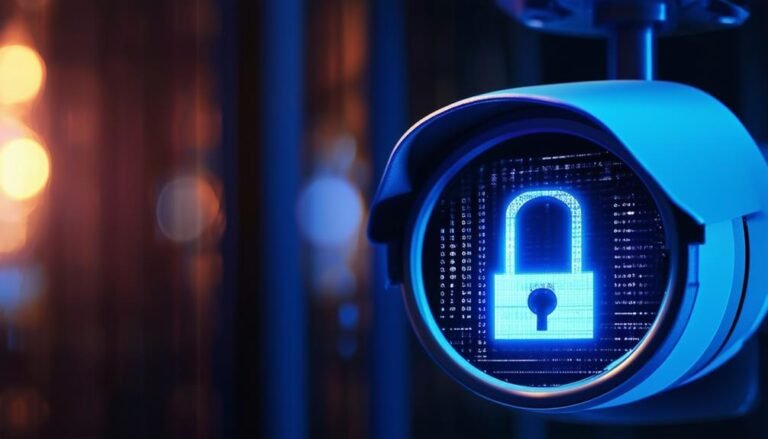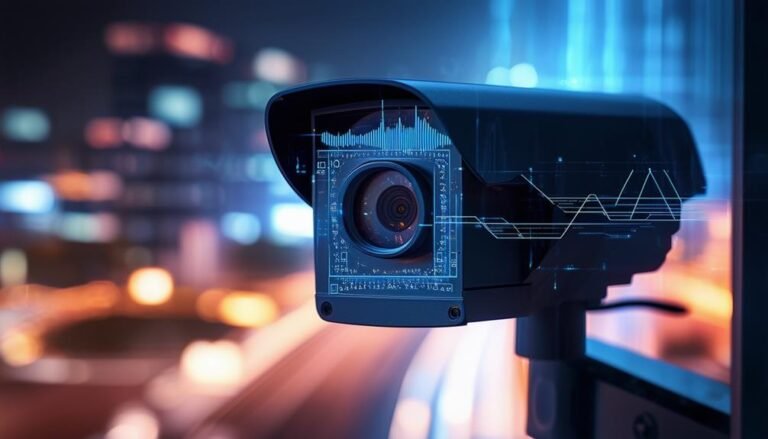To initialize your Dahua IP camera, start by unboxing and checking all components for damage. Gather a compatible power adapter, an Ethernet cable, and a laptop or smartphone. Connect the power supply, ensuring it fits the camera's voltage requirements. For networking, connect via Ethernet to your router or use Dahua's app for Wi-Fi setup. Access the camera interface through a web browser using its IP address, typically defaulting to "admin" for both login fields. Then, configure your camera settings, including resolution and motion detection. There's a lot you can adjust for ideal performance.
Unboxing Your Dahua IP Camera
Unboxing your Dahua IP camera is an exciting first step toward enhancing your security setup. As you peel back the packaging, you're greeted by the sleek design of your new camera, a device that promises to liberate you from uncertainty regarding your home or business's safety. You'll find the camera itself, along with essential components like the power adapter, mounting kit, and user manual. It's this moment of anticipation that fuels your desire for security and peace of mind.
Once you've removed everything from the box, take a moment to inspect the items. The camera should be free of any visible damage, and the cables should be intact. This is your opportunity to appreciate the technology that'll help you maintain control over your environment. You're not just setting up a camera; you're taking a stand for your freedom to feel secure.
As you lay out the components, consider where you'd like to position the camera. This is a vital part of the process, as the right location can greatly enhance your security coverage. Think about blind spots, entry points, and areas that need monitoring. This thoughtful approach reflects your commitment to safeguarding your space.
Now that you've unboxed your Dahua camera and familiarized yourself with its components, you're ready to move forward. The next steps will involve gathering the necessary tools, but for now, enjoy the sense of empowerment that comes with this initial phase.
Gathering Required Tools
Before you plunge into the installation process, it's vital to round up the tools you'll need. Having everything on hand will make the setup more efficient and enjoyable, allowing you to focus on getting your Dahua IP camera up and running. Here's a handy list to help you gather the essentials.
| Tool | Purpose | Notes |
|---|---|---|
| Screwdriver | For mounting the camera | A Phillips-head is common |
| Ethernet cable | To connect the camera to your network | Confirm it's long enough |
| Power adapter | To provide power to the camera | Check compatibility |
You might also want to take into account a drill if you're mounting the camera outdoors or on a hard surface. A level could come in handy too, confirming your camera is straight. If you're planning to configure settings, having a laptop or smartphone nearby is essential, as you'll need to access the camera's interface.
Connecting to Power Supply
To get your Dahua IP camera operational, connecting it to a power supply is essential. You'll want to verify a reliable power source so your camera can keep an eye on things without interruption. Here's what you need to take into account for a seamless connection:
- Power Adapter: Check if your camera comes with a compatible power adapter.
- Voltage Rating: Confirm the power supply matches the camera's voltage requirements, usually 12V.
- Cable Length: Use a cable long enough to reach from your power outlet to the camera's location.
- Environmental Conditions: If the camera's outdoors, think about weatherproof power connections.
- Surge Protection: Protect your camera from power surges with an appropriate surge protector.
Start by locating a power outlet near your camera's installation site. If your camera has a PoE (Power over Ethernet) option, you might be able to power it through your network cable, eliminating the need for a separate adapter. If you're using the standard power adapter, plug it into the outlet and connect it to the camera's power input.
Make sure the connection is snug to prevent any power interruptions. Once connected, check for any indicator lights on the camera to confirm that it's receiving power. You're now one step closer to setting up your Dahua IP camera and enjoying the freedom of monitoring your space securely!
Networking Your Camera
Once your Dahua IP camera is powered on, establishing a network connection is crucial for remote viewing and management. You've got a few options here, whether you prefer a wired or wireless setup. If you're going the wired route, simply connect an Ethernet cable from your camera to your router. This gives you a solid, stable connection and usually makes things easier to set up.
For a wireless connection, you'll need to access your camera's settings. First, make sure your camera is within range of your Wi-Fi network. In most cases, you'll use a computer or mobile device to configure the Wi-Fi settings. You might need to download the Dahua software or use an app to find your camera on the network. Once you've located it, enter your Wi-Fi credentials—SSID and password—and let the camera connect.
After you've set up the Wi-Fi connection, it's wise to assign a static IP address to your camera. This guarantees that its IP address doesn't change, making it easier to access in the future. You can do this through your router's settings.
Lastly, test your connection. You want to confirm that you can view the camera feed remotely, whether on your smartphone or computer. A well-established network connection not only gives you peace of mind but also the freedom to monitor your space anytime, anywhere. Enjoy the control that comes with your Dahua IP camera!
Accessing the Camera Interface
To access your Dahua IP camera's interface, you'll first need to guarantee it's connected to your network. Once that's set up, you can log into the web interface using your browser. This will give you control over the camera's settings and features.
Connection to Network
A reliable connection to your network is essential for accessing the Dahua IP camera interface. Without it, you won't be able to view or manage your camera effectively. Here's what you need to guarantee a solid connection:
- Choose the Right Connection Type: Decide between wired (Ethernet) or wireless (Wi-Fi) based on your needs.
- Check Network Compatibility: Make sure your router can support IP cameras and has enough bandwidth.
- Positioning: Place your camera within range of your Wi-Fi signal or ensure Ethernet cables are securely connected.
- Avoid Interference: Keep the camera away from electronic devices that could disrupt the Wi-Fi signal.
- Network Security: Set strong passwords and use encrypted connections to protect your camera from unauthorized access.
Web Interface Login
With your Dahua IP camera connected to the network, the next step is accessing the camera's web interface. This interface lets you manage settings, view live feeds, and customize your camera to suit your needs.
To get started, open a web browser and enter the camera's IP address. You'll be prompted to log in. Use the default username and password, which are often "admin" and "admin" (or check your camera's manual for specifics).
Here's a handy reference table for common credentials and settings:
| Setting | Default Value |
|---|---|
| Username | admin |
| Password | admin |
| IP Address Example | 192.168.1.108 |
Once you log in, it's wise to change the default password to enhance security. Explore the interface to discover various features available to you, allowing you to take full advantage of your camera's capabilities. Enjoy the freedom to monitor your surroundings effectively and tailor the settings to your unique requirements!
Configuring Camera Settings
Once you've successfully initialized your Dahua IP camera, configuring its settings is essential for ideal performance and security. This step allows you to tailor the camera to your specific needs, enhancing both its effectiveness and your peace of mind. Here's what you should focus on to get the most out of your camera:
- Resolution: Adjust the video resolution according to your bandwidth and storage capacity.
- Frame Rate: Set the frame rate that balances smooth video with data usage.
- Motion Detection: Enable motion detection and customize the sensitivity to minimize false alerts.
- Privacy Zones: Configure privacy zones to block out areas where you don't want to monitor.
- Storage Options: Choose your preferred storage method, whether it's local or cloud-based.
Once you've identified these settings, it's time to plunge in. Navigate through the web interface, and you'll find intuitive menus for each feature. Don't hesitate to experiment with different configurations until you find what feels right for you. Remember, you're in control of how your camera operates.
Keep in mind that the right settings can markedly enhance your surveillance experience. It might take a bit of time to fine-tune everything, but the freedom to customize your security setup is well worth it. Embrace this opportunity to create a system that fits seamlessly into your lifestyle. By doing so, you'll not only guarantee security but also maintain the flexibility that makes your environment feel safe and personal.
Updating Firmware
Updating the firmware of your Dahua IP camera is essential for guaranteeing ideal performance and security. Firmware updates often include bug fixes, new features, and security enhancements that help protect your device from vulnerabilities. Here's how you can easily update your camera's firmware:
- Check the Current Firmware Version: Log into your camera's interface and navigate to the "Firmware" section to see which version you're currently using.
- Download the Latest Firmware: Visit the Dahua website or your camera's support page to find the latest firmware for your specific model. Make sure to download the correct version to avoid issues.
- Prepare for the Update: Before proceeding, guarantee your camera is powered on and connected to the internet. It's also a good idea to back up your current settings.
- Upload the New Firmware: In the camera interface, go to the "Upgrade" section, choose the downloaded firmware file, and click "Update". This process might take a few minutes.
- Reboot the Camera: Once the update is complete, your camera will usually reboot automatically. If not, you may need to do it manually.
Here's a quick summary of the firmware update process:
| Step | Action |
|---|---|
| Check Version | Log into the interface |
| Download Firmware | Visit the Dahua website |
| Prepare for Update | Guarantee power and backup |
| Upload New Firmware | Select and update |
Testing Camera Functionality
Now that you've updated the firmware, it's time to test your camera's functionality. Start by verifying the network connection to guarantee it's properly linked, then check the video feed for clarity and responsiveness. Finally, adjust the camera settings to suit your specific needs for ideal performance.
Verify Network Connection
Verifying your Dahua IP camera's network connection is essential for confirming its functionality. A reliable connection means you can access your camera remotely, monitor your space, and enjoy peace of mind. Here are some key steps you should take to check your network connection:
- Check the power supply: Confirm your camera is powered correctly to avoid connectivity issues.
- Inspect Ethernet cables: Look for any damage or loose connections that might disrupt the signal.
- Verify router settings: Make sure the router is functioning properly and that the camera is connected to the right network.
- Ping the camera's IP address: Use a command prompt to check if the camera responds, indicating it's online.
- Test with another device: Try connecting another device to the same network to rule out issues with your internet service.
Check Video Feed
Once you've confirmed your Dahua IP camera's network connection, it's time to check the video feed to verify everything's working smoothly. Start by accessing the camera's interface through a web browser or the designated app. Enter the camera's IP address, and log in with your credentials. Once you're in, look for the live view option; this is where you'll see the real-time video feed.
Take a moment to assess the image quality. Is the feed clear, or does it look grainy? Check for any lag or interruptions in the stream. If you notice any issues, it might be due to bandwidth limitations or a weak Wi-Fi signal.
Don't forget to test the camera's features, too. If your camera has pan-tilt-zoom (PTZ) capabilities, try moving the camera around to verify it responds well. Check if the night vision works by covering the lens to simulate low light conditions.
Adjust Camera Settings
Adjusting your Dahua IP camera settings is essential for optimizing its functionality and guaranteeing it meets your surveillance needs. Once you've confirmed the video feed is working, it's time to tweak a few settings to enhance performance. Here are some key adjustments you might consider:
- Resolution: Set the resolution to balance clarity and bandwidth usage.
- Frame Rate: Adjust the frame rate according to your activity level—higher for busy areas, lower for quieter zones.
- Motion Detection: Customize motion detection zones to avoid false alarms from passing cars or trees swaying.
- Image Settings: Fine-tune brightness, contrast, and saturation for clearer images, especially in varying light conditions.
- Network Settings: Guarantee your camera is connected securely and optimize the bandwidth allocation.
Troubleshooting Common Issues
When it comes to troubleshooting common issues with your Dahua IP camera, a few key steps can often resolve many problems quickly. First, check the power supply. Make sure your camera is plugged in properly and that the outlet is functioning. If you're using PoE (Power over Ethernet), verify the switch is operational.
Next, verify your network connection. If your camera isn't connecting, check your router settings. Verify the camera is on the same network as your viewing device. You might want to reset the camera's network settings to default if you're having persistent issues.
If you're experiencing video loss or poor quality, inspect the camera lens for dirt or obstructions. A simple wipe can often restore clarity. Also, confirm that your firmware is up to date; outdated software can lead to functionality problems.
For cameras that won't respond, a hard reset might be necessary. Locate the reset button, usually found on the back or bottom of the device. Press and hold it for about 10 seconds, but remember, this will erase your settings, so use this as a last resort.
Frequently Asked Questions
Can I Use Dahua Cameras With Other Brands' Software?
Yes, you can use Dahua cameras with software from other brands, but it depends on compatibility. Many third-party software solutions support ONVIF protocols, which allow devices from different manufacturers to communicate. However, you might face some limitations regarding features and settings. It's always a good idea to check the specific software's compatibility before making a decision. This way, you can enjoy the flexibility and freedom to choose what works best for your setup.
What Is the Lifespan of a Dahua IP Camera?
You might think Dahua IP cameras won't last long, but that's not the case. Typically, these cameras have a lifespan of around 5 to 7 years, depending on usage and environmental conditions. To maximize their longevity, make certain they're installed in suitable locations and maintained regularly. By taking care of them, you'll enjoy reliable performance and peace of mind for years, allowing you the freedom to focus on what really matters to you.
Are Dahua IP Cameras Weatherproof?
Yes, Dahua IP cameras are generally weatherproof, designed to withstand various environmental conditions. They often come with IP ratings, indicating their resistance to dust and moisture. If you're planning to install one outdoors, it's vital to check the specific model's rating to guarantee it meets your needs. By choosing the right camera, you can feel confident that your surveillance system will remain functional and reliable, regardless of the weather.
How Can I Reset My Dahua IP Camera?
If you need to reset your Dahua IP camera, it's pretty straightforward. Just locate the reset button, usually found on the camera itself. Press and hold that button for about 10 seconds until you see the indicator light change. This'll restore the camera to its factory settings, giving you a fresh start. Remember, you'll lose any custom settings, so be prepared to set it up again afterward!
Do Dahua Cameras Support Cloud Storage Options?
Dahua cameras are like a safety net for your peace of mind. Yes, they do support cloud storage options, allowing you to store your footage securely off-site. This means you won't have to worry about losing important recordings if something happens to your local storage. You can access your videos anytime, anywhere, giving you the freedom to monitor your property without being tied down to physical storage devices. Enjoy that flexibility!



